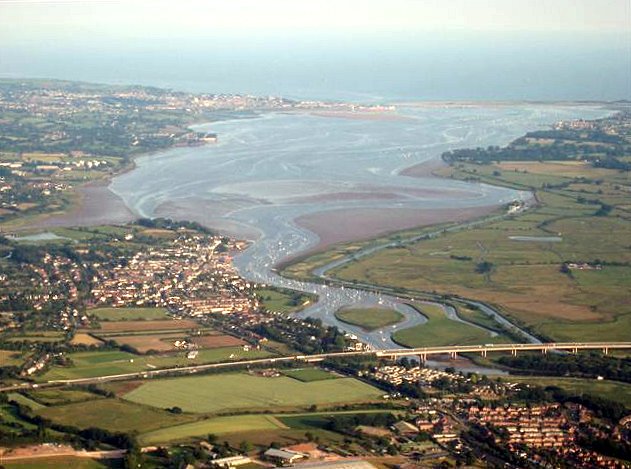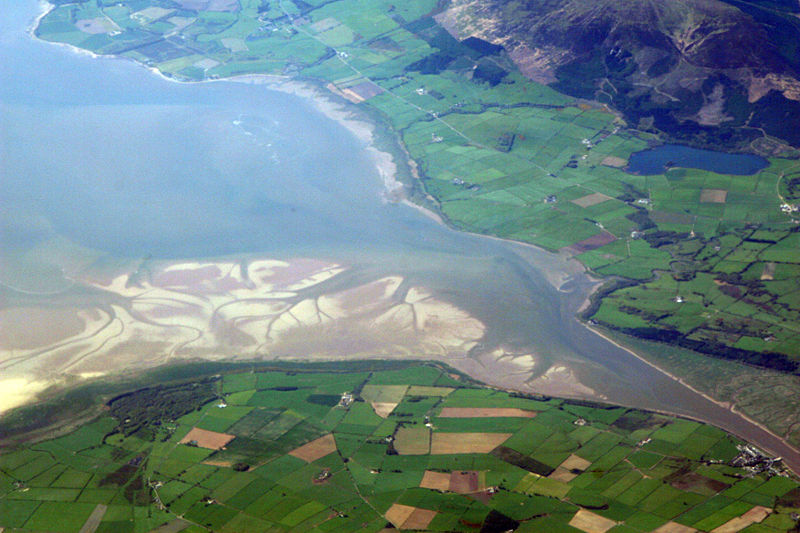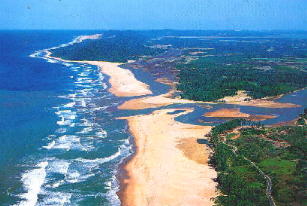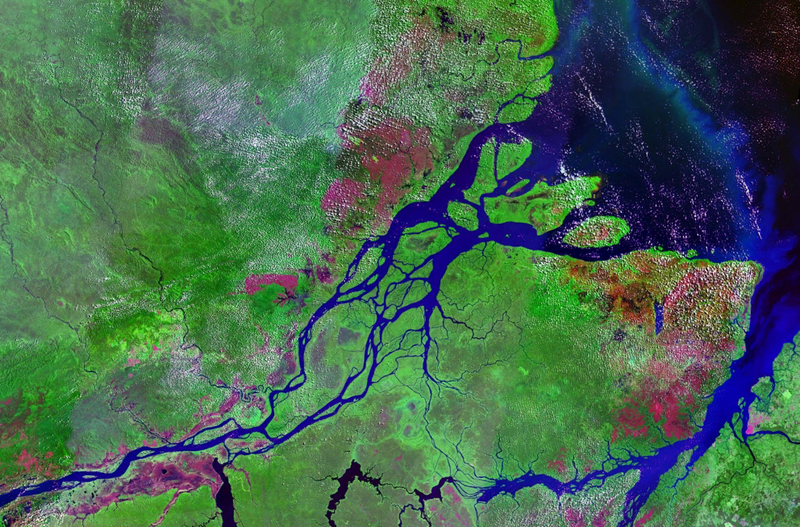Estuarine Fisheries
Majority of the flowing waters on the earth finally reach the sea. Exceptions to this are small rivers, and brooks in inland areas that either join the seasonal standing waters, or themselves dry up after flowing for certain distance. Near to the cost even small brooks, channels and streams join the sea after traversing small distances. At and near the juncture where the river joins sea, a unique aquatic environment is created having the characteristics of both the marine and freshwaters virtually an admixture of these two environments. This water mass is usually called as a buffer zone or ecotone. Estuaries thus come into existence at an area of the sea coast where the river joins the sea. An estuary is defined as a semi-enclosed coastal body of water, which has a free connection with the open sea and within which the seawater is measurably diluted with the freshwater of land drainage.
Features of estuary
Several unique features are seen most estuaries with regards to the physics, chemistry, geology and biological features.
-
The fast flowing rivers of upland regions lose their velocity and turbulence and become nearly still except for the changes brought about by tides.
-
The depth and width generally increases.
-
Waters tend to become clear due to settling of suspend matter caused by great reduction in velocity.
-
The bottom of the estuary gets built up due to deposition of materials brought by the floodwaters.
-
Physical environmental characteristics like penetration of light and temperature change compared to shallow upland river stretches.
-
Salinity, dissolved gasses and chemical nutrients again show variations from that in the upper stretches.
-
The estuary shows distinct seasonal variations in several of the physic-chemical and biological characters, particularly those waters, which come under monsoonal regime. The estuary can show marine, freshwater and intermediary characters nearly freshwater during monsoon season and flooding periods, marine characteristics in pre-monsoon or summer and between monsoons an admixture feature of seawater and freshwaters.
-
Tidal regimes also influence the estuarine characters with high tide bringing more seawater into the region and on withdrawal of same during low tide with more freshwater entering the area.
-
Biologically an estuary is more unique in allowing the development of a set plants and animals that only can thrive in a buffer media of estuary. Euryhaline organisms capable of tolerating some degree of variation in salinity of the waters develop and thrive here.
-
Estuaries thus support freshwater life forms, marine forms and finally the brackish water forms, capable of inhabiting waters with changing salinity features. Also, this environment will support pure freshwater forms in the upper reaches, euryhaline forms in the middle regions and stenohaline forms in areas near to the mouth. During flooding and monsoon conditions, only freshwater forms are present and during dry period or summer with no or less freshwater inflow more marine forms inhabit the region and the euryhaline brackish water forms exist during rest of the period.
-
The estuaries are considered as the highly productive aquatic ecosystems for all forms of aquatic life including benthic forms.
-
They are ideal and favourable nursery areas for a wide variety of commercially important marine finfishes and shellfishes, as the waters are more sheltered with favourable conditions for breeding and feeding. An assortment of food components, i.e. phytoplankton and zooplankton, thrive here to help for the growth and development of different fishes and shellfishes.
-
Many estuaries support a thriving commercial fishery of brackish water finfishes and shellfishes.
-
Owing to their sheltered nature, estuaries offer safe navigation and anchoring of boats and ships.
Major estuarine systems of India
India has rich estuarine and other brackish water resources along the east and west coasts (Table 10.1) formed by the Ganges, Mahanadhi, Brahmaputra, Godavari, Krishna, Cauvery, Narmadha and Tapati rivers, and smaller coastal rivers along the west coast, mainly in Kerala, Karnataka and Goa.
The total brackish water resources of India as estimated by the Government of India (1990) was 2.0 million ha, later reassessed as 1.44 million ha (Government of India, 2000). The states of Orissa, Gujarat, Kerala and West Bengal have rich brackish water resources. West Bengal is endowed with rich brackish water area, estimated to be 405,000 ha with Hooghly-Matlah estuary accounting for 8,029 km² and marshy area of Sunderbans to be 2,34o km².
Orissa has a total brackish water resource of 417,537 ha. Estuaries, lakes and backwater account for 247,850 ha, 79,000 ha and 8,100 ha respectively. The Chilka lake is the biggest brackish water lagoon of the east coast of India. The area during summer and rainy season has been estimated to be 906 and 1,105 km² respectively.
Andhra Pradesh with a coastline of 900 km has 9 coastal districts. The brackish water of the state is about 2.0 lakh ha and mangrove swamp of 27,500 ha. Pulicat lake is a very important brackish water lake of the region with a total area 77,000 ha. The Godavari estuarine system has an area of 330 km².
The Vellar River joins the Bay of Bengal at Porto Novo at which point the Vellar estuary with an area of 260 ha is formed. The estuary has a width of 200 m and has a mean depth of 2.5 m. the mouth of the river is open to the sea throughout the year. The estuary is very productive. Muthupet estuary is located in Nagi district near Thanjavur, and has an area of 20,000 ha.
Table 10.1 Brackish water resources of India
State |
Area (lakh ha) |
Area (ha) |
West coast
Gujarat
Maharashtra
Karnataka
Kerala
East coast
Tamil Nadu
Andhra Pradesh
Orissa
West Bengal
Pondicherry
Andaman & Nicobar Islands |
3.76
0.10
0.08
2.43
0.56
0.79
4.17
2.10
0.01
0.37 |
30,000
-
-
50,000
-
18,000
30,000
802,900
-
- |
(Source: Hand book of Fisheries and Aquaculture. 2006. Indian Council of Agricultural Research. New Delhi.)
Implications for marine life
Estuaries provide habitats for a large number of organisms and support very high productivity. Estuaries provide habitats for many fish nurseries, depending upon their locations in the world, such as salmon and sea trout. Also, migratory bird populations, such as the black-tailed godwit, Limosa limosa islandica make essential use of estuaries.
Two of the main challenges of estuarine life are the variability in salinity and sedimentation. Many species of fish and invertebrates have various methods to control or conform to the shifts in salt concentrations and are termed
osmoconformers and osmoregulators. Many animals also burrow to avoid predation and to live in the more stable sedimental environment. However, large numbers of bacteria are found within the sediment which have a very high oxygen demand. This reduces the levels of oxygen within the sediment often resulting in partially anoxic conditions, which can be further exacerbated by limited water flux.
Plankton are key primary producers in estuaries. They move with the water bodies and can be flushed in and out with the tides. Their productivity is largely dependant upon the turbidity of the water. The main plankton present are diatoms and dinoflagellates which are abundant in the sediment.
It is important to remember that a primary source of food for many organisms on estuaries, including bacteria, is detritus from the settlement of the sedimentation.
Human impacts
Of the 32 largest cities in the world, 22 are located on estuaries.[2] For example, New York City is located at the mouth of the Hudson River estuary.
As ecosystems, estuaries are under threat from human activities such as pollution and [overfishing]. They are also threatened by sewage, coastal settlement, land clearance and much more. Estuaries are impacted by events far upstream, and concentrate materials such as pollutants and sediments. Land run-off and industrial, agricultural, and domestic waste enter rivers and are discharged into estuaries. Contaminants can be introduced which do not disintegrate rapidly in the marine environment, such as plastics, pesticides, furans, dioxins, phenols and heavy metals.

Estuary Surrounded by Cities
Such toxins can accumulate in the tissues of many species of aquatic life in a process called bioaccumulation. They also accumulate in benthic environments, such as estuaries and bay muds: a geological record of human activities of the last century.
For example, Chinese and Russian industrial pollution, such as phenols and heavy metals, in the Amur River have devastated fish stocks and damaged its estuary soil.
Estuaries tend to be naturally eutrophic because land runoff discharges nutrients into estuaries. With human activities, land run-off also now includes the many chemicals used as fertilizers in agriculture as well as waste from livestock and humans. Excess oxygen depleting chemicals in the water can lead to hypoxia and the creation of dead zones. It can result in reductions in water quality, fish, and other animal populations.
Overfishing also occurs. Chesapeake Bay, North America's largest estuary[once had a flourishing oyster population which has been almost wiped out by overfishing. Historically the oysters filtered the estuary's entire water volume of excess nutrients every three or four days. Today that process takes almost a year, and sediment, nutrients, and algae can cause problems in local waters. Oysters filter these pollutants, and either eat them or shape them into small packets that are deposited on the bottom where they are harmless.

River Nith Estuary
 
(Source:www.wikipedia.com) |




